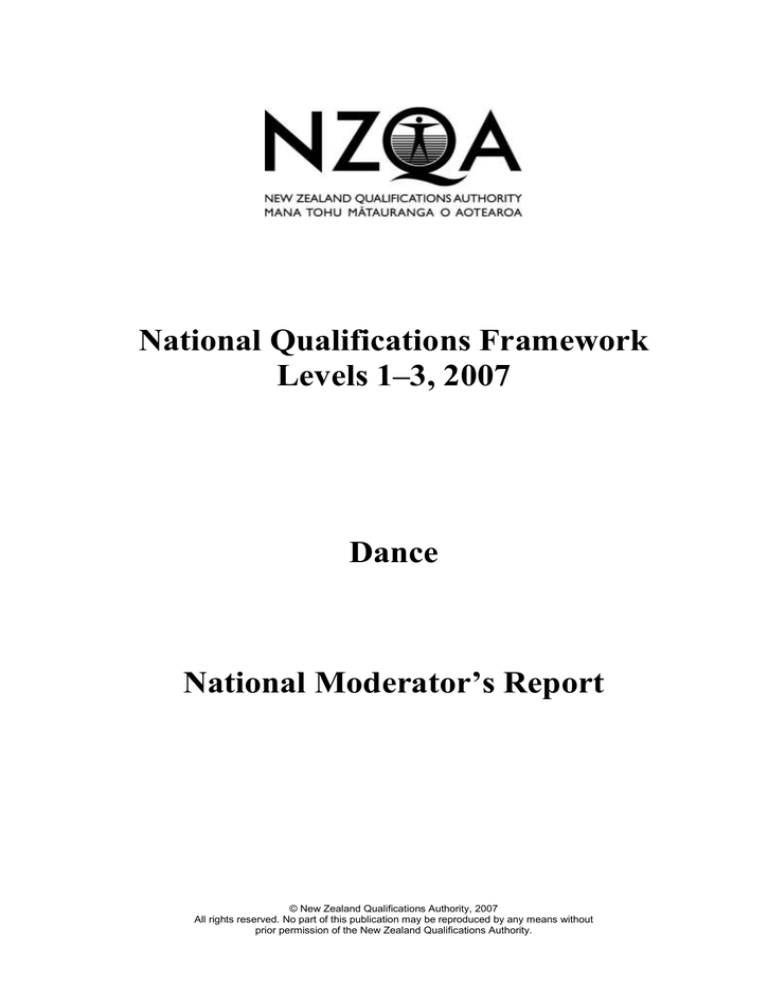
National Qualifications Framework
Levels 1–3, 2007
Dance
National Moderator’s Report
© New Zealand Qualifications Authority, 2007
All rights reserved. No part of this publication may be reproduced by any means without
prior permission of the New Zealand Qualifications Authority.
National Qualifications Framework Levels 1–3 (Dance) 2007 — page 2
NATIONAL MODERATOR REPORT FOR DANCE
General Guidance for Assessors of Achievement and Unit Standards
The purpose of external moderation is to provide reassurance that assessor judgments are at the
national standard and are made on the basis of assessment materials that are fair and valid. All
assessment materials are expected to:
•
give the learner the opportunity to meet the requirements of the standard
•
have an assessment schedule that gives evidence of appropriate learner responses and
clear judgments at all levels.
The Ministry of Education contracted subject experts to write assessment resources for
achievement standards. These are not pre-moderated. The intention is that they are modified to
suit teaching programmes and learner needs. They do not provide “rules” but suggest different
ways of assessing to the nationally registered standard.
Assessors of Dance achievement standards were assessing at or close to the national standard.
For the most part, materials submitted for moderation indicated that learners were experiencing a
range of dance genres within different contexts and that they were being given appropriate
assessment tasks for a particular achievement standard.
However, assessment schedules often required more detailed examples of what learners need to
be able to show or do to achieve at the different levels, specific to the dance genre or task. While
the current assessment resources from TKI provide good guidance for possible assessment tasks
and schedules, any modification to suit the local teaching/learning situation must inevitably
require modification of the assessment schedule to ensure clarity and validity for learners.
Whether a dance for performance is taught directly to the learners as a finished product or is
being created collaboratively during the teaching/learning process, an assessment schedule that
includes a variety of possible performance indicators at each level of achievement is essential for
learners.
There are issues with videoing large group dances and performances in stage lighting where
individuals are not being seen clearly and consistently enough to be able to support assessment
judgements. For the purposes of moderation, a variety of solutions are being implemented to
address these problems such as: videoing learners as individuals, a pair or in small groups;
providing a second recording of a performance without stage lighting; providing diagrams of
where a student is located in specific parts of a dance; giving several details about a student’s
appearance (not just clothing or hair) on the Student Identification for Video Evidence forms;
making sure that the final moment of ‘performances’ is not abruptly cut off.
Teachers are reminded that there are resources to assist with the teaching and assessing of dance
unit standards at http://www.nzqa.govt.nz/for-providers/resources/dance.html
90295: Perform an ethnic or social dance.
This standard is intended for learners to demonstrate their skills and understanding in performing
an ethnic or social dance.
National Qualifications Framework Levels 1–3 (Dance) 2007 — page 3
Where the dance requires the performers to have different roles that require them to show
different skills or attributes e.g. an energetic leader vs. a subdued follower, it is advisable to
include examples of the technique, focus, expression and stylistic characteristics expected of
these roles in the dance genre/style at each level. This should be made explicit to the learners in
the assessment schedule.
It may be relevant to include examples of practices (conventions, protocols, etiquette and/or
principles) appropriate to the ethnic or social dance in the assessment schedule e.g. lead partner
smoothly into the space.
Where learners have been asked to wear a costume or appropriate clothing for assessment,
details clarifying what is appropriate for the dance being performed is useful for moderation.
While lending authenticity to the ethnic or social dance being performed, dancing in special
clothing or footwear e.g. sari, high-heel shoes, can present movement challenges which may
require considerable practice by the learners before assessment day so as not to undermine their
achievement.
90203: Choreograph a section of dance for a group; 90295: Choreograph a solo dance;
90594: Produce a dance for performance
These standards require learners to choreograph a section of dance or to choreograph a solo
dance, to communicate a chosen idea, mood or image or to develop a concept for
choreographing… a dance.
At all levels, in order to be able to achieve the standards, learners need to have a clear
understanding of what they are intending to communicate to the audience through their dance. It
is expected therefore that the learners will be able to describe the chosen idea/mood/image
and/or the choreographic intention of their dance (see Explanatory Notes). This information may
be presented in oral, written and/or visual form.
A few words or a single statement to explain the idea, mood, image and/or choreographic
intention is seldom sufficient for being able to make secure judgements about the learners’
ability to manipulate the elements of dance and use choreographic devices with relevance. TKI
assessment resources for 90203 and 90295 advise that learners write a paragraph about their
dance idea, mood or image. To assist learners to write with detail or clarity, teachers may need to
provide them with specific questions to help them explain and justify their choreographic ideas
and choices. TKI assessment resources for 90594 give examples of how this information may be
captured.



